| Home > Policy > White Paper, Notice, Announcement > White Paper > Annual Report on the Promotion of Science and Technology 1999 > Part1 Chapter2 Section2 2 | ||
| (Observations Based on Number of Patents) |
![]() Since 1990, patent applications by Americans has been increased
approximately 330%, with a significant increase in applications in foreign countries.
Domestic patent applications by Japanese account for a large percentage of the
total, which has remained roughly level.
Since 1990, patent applications by Americans has been increased
approximately 330%, with a significant increase in applications in foreign countries.
Domestic patent applications by Japanese account for a large percentage of the
total, which has remained roughly level.
![]() In 1996, Japan ranked first worldwide in number of patent
registrations, with the U.S. ranking second.
In 1996, Japan ranked first worldwide in number of patent
registrations, with the U.S. ranking second.
![]() When looking at the number of patents registered in foreign
countries by Japanese and Americans in separate fields of technology, Japanese
registered more patents in information storage devices, engines and electronic
components but is behind Americans in pharmaceuticals, biotechnology, and petrochemicals
( Fig. 10 ).
When looking at the number of patents registered in foreign
countries by Japanese and Americans in separate fields of technology, Japanese
registered more patents in information storage devices, engines and electronic
components but is behind Americans in pharmaceuticals, biotechnology, and petrochemicals
( Fig. 10 ).
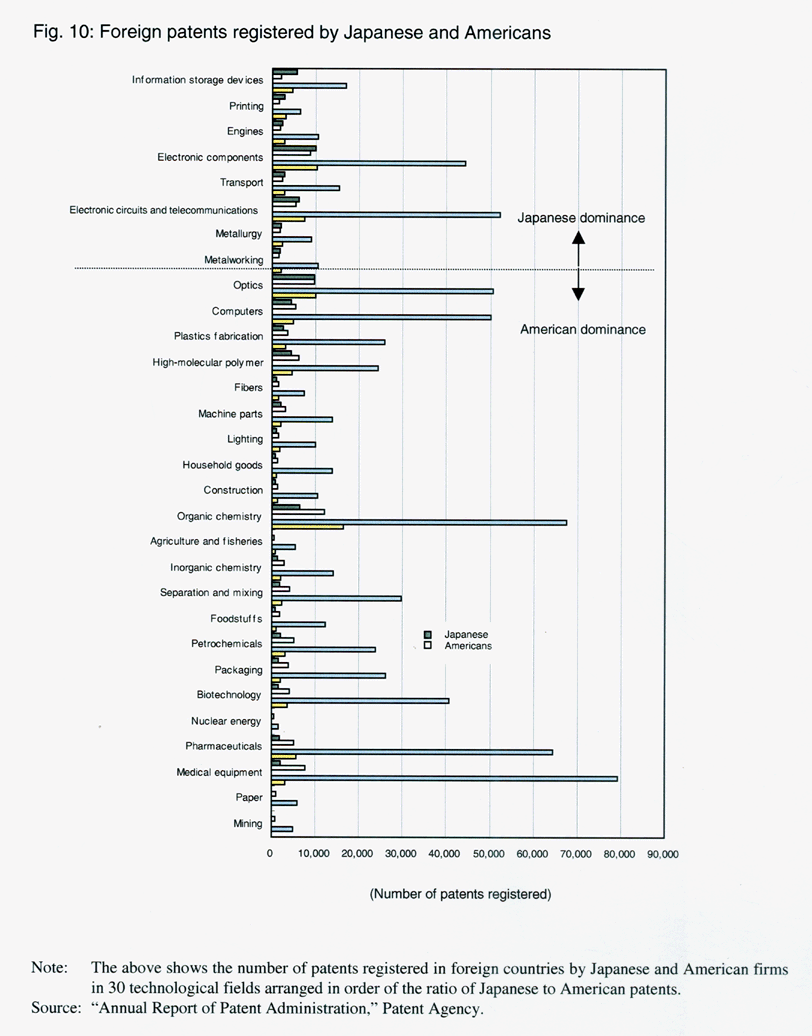
| (Japanese Products with High Market Share) |
![]() Products produced by Japanese corporations include those with
high market share: semiconductor wafers (more than 75%), denitration catalysts,
which are important in environmental conservation (100%), hydrogen absorbing
alloys (100%), and plastic fiberoptics (100%), among others.
Products produced by Japanese corporations include those with
high market share: semiconductor wafers (more than 75%), denitration catalysts,
which are important in environmental conservation (100%), hydrogen absorbing
alloys (100%), and plastic fiberoptics (100%), among others.
| (Private Sector Awareness) |
![]() Although Japanese private enterprises in many sectors view
their technological abilities as either superior to or on a competitive level
with those of North America and Europe, the U.S. is seen as dominant in the information
service industry, and the U.S. and Europe as dominant in pharmaceuticals, by
an overwhelmingly large number of Japanese businesses.
Although Japanese private enterprises in many sectors view
their technological abilities as either superior to or on a competitive level
with those of North America and Europe, the U.S. is seen as dominant in the information
service industry, and the U.S. and Europe as dominant in pharmaceuticals, by
an overwhelmingly large number of Japanese businesses.
![]() Surveys by the Japan Federation of Economic Organizations
(Keidanren) and others also show that the private sector sees itself as competitive
in such industries as consumer electronics and appliances, nonferrous metals,
semiconductor devices, and foodstuffs, but uncompetitive in software, paper and
pulp, engineering, and pharmaceuticals ( Fig.
11 ).
Surveys by the Japan Federation of Economic Organizations
(Keidanren) and others also show that the private sector sees itself as competitive
in such industries as consumer electronics and appliances, nonferrous metals,
semiconductor devices, and foodstuffs, but uncompetitive in software, paper and
pulp, engineering, and pharmaceuticals ( Fig.
11 ).
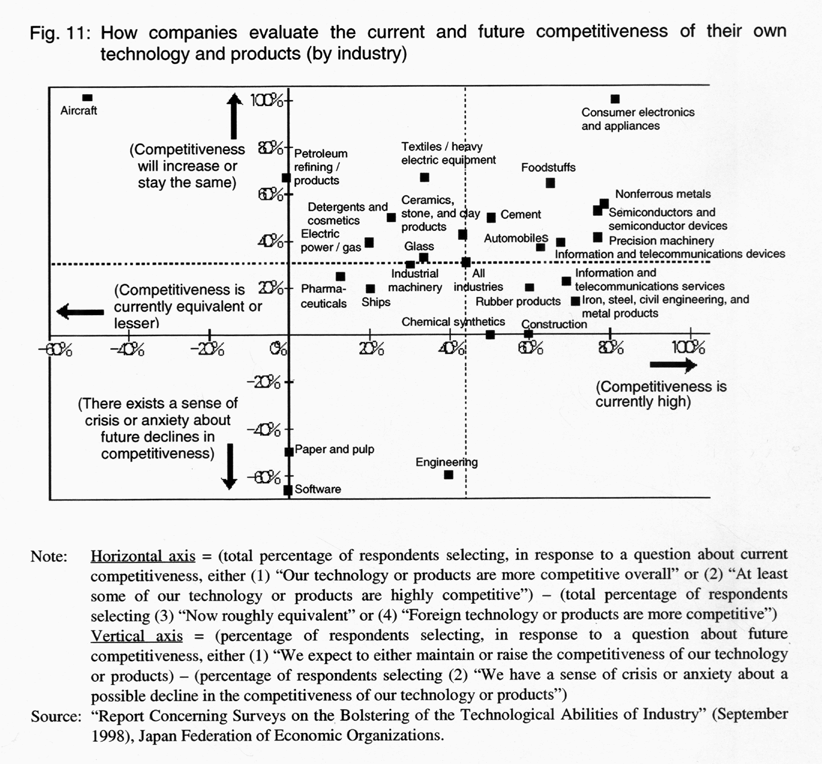
| (Overview) |
![]() Private enterprises indicate that future R&D investment
will emphasize R&D relating to product technology ( Fig.
12 ), and that they intend to shorten product lead-in periods in order to
speed up product changeovers and thereby assure competitiveness. As for human
resources, there is a tendency to employ researchers in mid-career (i.e., those
with experience at other companies, etc.) because of their proven abilities ( Fig.
13 ).
Private enterprises indicate that future R&D investment
will emphasize R&D relating to product technology ( Fig.
12 ), and that they intend to shorten product lead-in periods in order to
speed up product changeovers and thereby assure competitiveness. As for human
resources, there is a tendency to employ researchers in mid-career (i.e., those
with experience at other companies, etc.) because of their proven abilities ( Fig.
13 ).
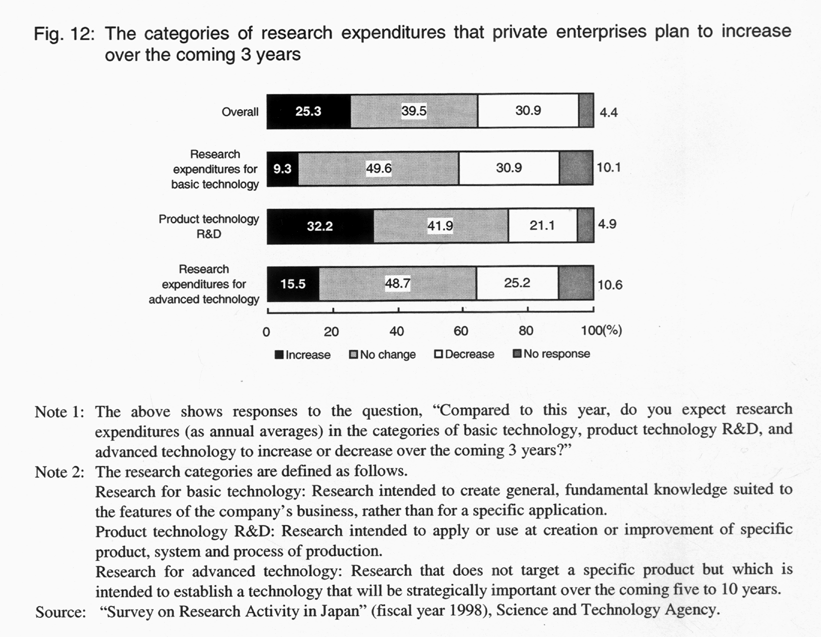
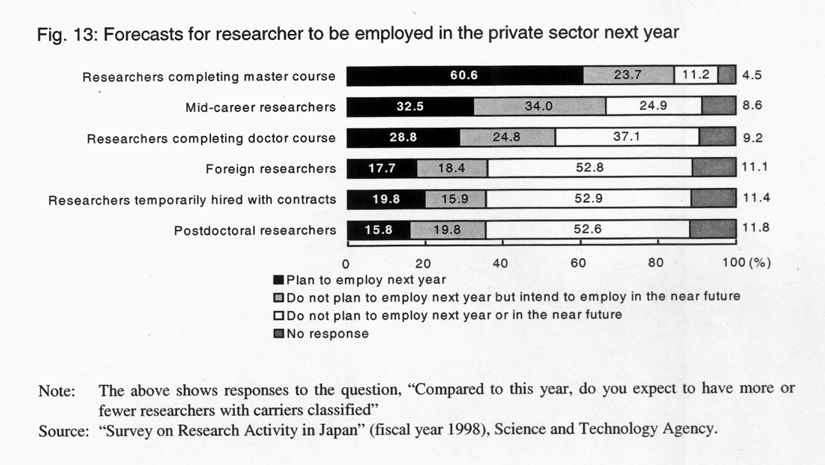
![]() In order to overcome the fierce technological competition
it faces, Japan's private sector must use R&D to create new and original
products and services and even new industries.
In order to overcome the fierce technological competition
it faces, Japan's private sector must use R&D to create new and original
products and services and even new industries.
| (Promoting Private Sector R&D) |
![]() To promote private sector R&D more over under current
circumstances, various support measures have been implemented, including tax
incentives for R&D investment and financial support for R&D at small
and medium enterprises and venture companies.
To promote private sector R&D more over under current
circumstances, various support measures have been implemented, including tax
incentives for R&D investment and financial support for R&D at small
and medium enterprises and venture companies.
![]() Other examples are the revised tax deductions for increases
in research expenditures and the small and medium enterprise technological innovation
programs (Japan's version of SBIR) provided under the New Enterprise Creation
Promotion Law, enacted on February 16, 1999.
Other examples are the revised tax deductions for increases
in research expenditures and the small and medium enterprise technological innovation
programs (Japan's version of SBIR) provided under the New Enterprise Creation
Promotion Law, enacted on February 16, 1999.
| (Expectations on Universities and National Research Institutes) |
![]() As they place increasing emphasis on product technology R&D,
the private sector is also placing greater expectations on research at universities
and national research institutes, whose role is growing as a source of knowledge
for new products and services and the seeds of new industries.
As they place increasing emphasis on product technology R&D,
the private sector is also placing greater expectations on research at universities
and national research institutes, whose role is growing as a source of knowledge
for new products and services and the seeds of new industries.
![]() More specifically, universities are looked toward as a place
of research that emphasizes on their own initiative, while the national research
institutes are seen as places capable of hosting high-risk, high-cost research
and research with the potential to generate economic rewards ( Fig.
14 ).
More specifically, universities are looked toward as a place
of research that emphasizes on their own initiative, while the national research
institutes are seen as places capable of hosting high-risk, high-cost research
and research with the potential to generate economic rewards ( Fig.
14 ).
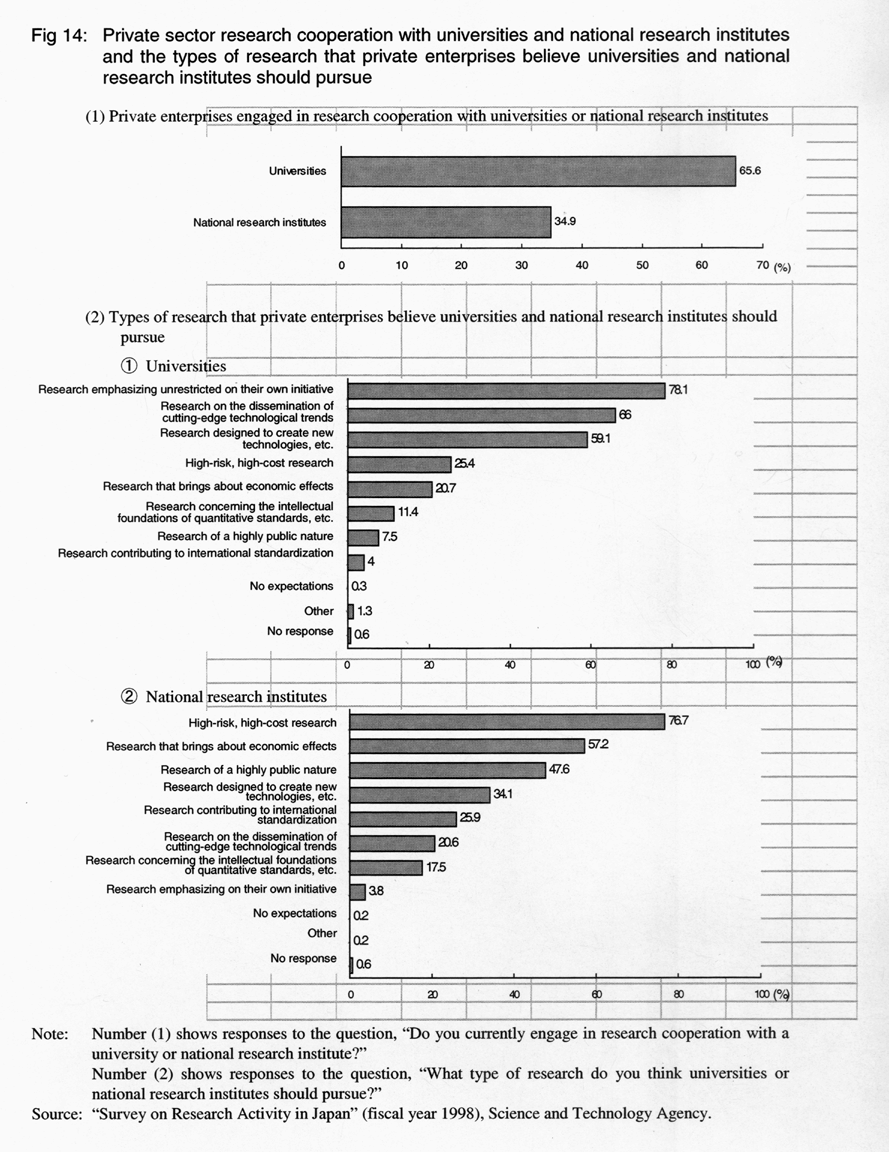
![]() At the same time, as problems affecting the availability of
the achievements of research at universities and national research institutes,
the private sector cites the failure to specify the sources of research information
and to release information in readily usable formats ( Fig.
15 ).
At the same time, as problems affecting the availability of
the achievements of research at universities and national research institutes,
the private sector cites the failure to specify the sources of research information
and to release information in readily usable formats ( Fig.
15 ).
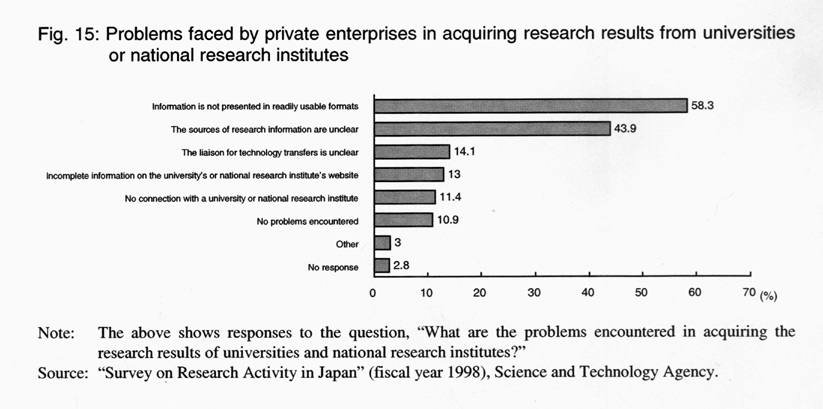
![]() Universities and national research institutes, however, are
by no means being called on to pay excessive attention to the immediate needs
of the private sector. What is important is that they vigorously pursue the kinds
of activities that expand intellectual resources by creating new knowledge and
combining existing knowledge. One example is the creation of new systems of knowledge
in response to socioeconomic needs, which also include the needs of industry.
Furthermore, efforts are needed to make the results of such endeavors apparent
to industry, and to expedite the transfer of knowledge through active patenting.
Universities and national research institutes, however, are
by no means being called on to pay excessive attention to the immediate needs
of the private sector. What is important is that they vigorously pursue the kinds
of activities that expand intellectual resources by creating new knowledge and
combining existing knowledge. One example is the creation of new systems of knowledge
in response to socioeconomic needs, which also include the needs of industry.
Furthermore, efforts are needed to make the results of such endeavors apparent
to industry, and to expedite the transfer of knowledge through active patenting.
| Back to Top | MEXT HOME |